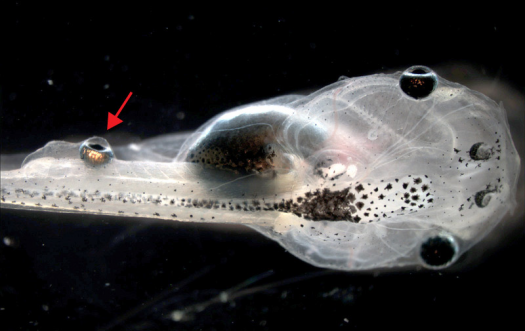神奇的研究:将蝌蚪眼睛植入其尾部 居然看到了光明
| 导读 |
据国外媒体报道,从古到今,在孩子看来,妈妈的后脑勺上长着眼睛,因为他们无论背着妈妈做什么,妈妈似乎都知道。但如今,“后脑勺长眼睛”的事儿有望变成现实。科学家有史以来第一次证明,将眼睛植入到蝌蚪的尾部,眼睛仍然可以看东西。
这些研究人员把这一研究结果用“令人震惊”来形容。塔夫斯大学艺术与科学学院的生物学家指出,这一重大发现有众多深远影响,尤其对... |

据国外媒体报道,从古到今,在孩子看来,妈妈的后脑勺上长着眼睛,因为他们无论背着妈妈做什么,妈妈似乎都知道。但如今,“后脑勺长眼睛”的事儿有望变成现实。科学家有史以来第一次证明,将眼睛植入到蝌蚪的尾部,眼睛仍然可以看东西。
这些研究人员把这一研究结果用“令人震惊”来形容。塔夫斯大学艺术与科学学院的生物学家指出,这一重大发现有众多深远影响,尤其对再生医学领域具有重要意义。
这项新研究的负责人迈克尔-莱文说:“异位眼和脊髓连接而不是直接连接到大脑时,接受蝌蚪依然能看得见事物,这种能力真是令人震惊。医学的首要目标是有朝一日用生物或人造更换部件恢复受损或缺少的感官结构。这项研究有许多深远意义,但从医学角度来看,它的主要意义是治疗失明等感觉障碍时无需和大脑建立特殊连接。”
生物学家在实验中通过外科手术取出捐赠蝌蚪的眼睛,然后把它们植入接受蝌蚪的尾部,诱发这些异位眼的生长。研究人员移除接受蝌蚪的天生眼,只留下和脊髓连接的异位眼。这些科学家用常见实验室动物非洲爪蟾的134个蝌蚪进行实验。
他们把这些两栖动物研究对象放在一个有水的碟中,用红光照射它的一半,用蓝光照射另一半,在有规律的时间间隔中调换这两种光。实验期间,不管蝌蚪何时闯入被红光照射的一半碟子,就会受到一个小小的电击警告。这个科研组获得令人兴奋的发现:19%以上视神经和脊柱连接的蝌蚪对光作出反应。蓝光刺激自然运动时,它们就游离红
研究人员用拥有完整天生眼的蝌蚪对照组进行实验,结果发现它们对光作出同样反应。但这种反应并没有在失明或没有受到任何电击的蝌蚪身上得到验证。莱文说:“我们的发现前所未有。没人会想到蝌蚪侧腹上的眼睛能看得见,尤其是在只把眼睛和脊髓而不是大脑连接时。”
原文链接:
Scientists Put A Working Eyeball On A Tadpole's Tail
It's hard to say what's crazier: the fact that Tufts University researchers spent a year cutting out the tiny eyeballs of tadpole embryos and sticking them back on to the tadpoles' tails, or: the fact that, when they hatched, a few of the tadpoles COULD ACTUALLY SEE OUT OF THE EYES ON THEIR TAILS.
As you know, this is not the way vision is supposed to work--your eyeballs are supposed to be connected to a big fat nerve that carries incoming signals back to your brain, which combines the information from both your eyes into a 3D picture of the world in front of you. Without that direct link to the brain, your eyeballs are useless.
At least, that's the way scientists have thought about it for the last several centuries. But over the past few decades, experiments in animals and humans have repeatedly shown that the central nervous system--including the brain and spinal cord--is a lot more flexible and adaptable than people used to think it was. If one part of the brain gets damaged, for instance, the information that used to flow to the damaged sector is often re-routed, and another part of the brain takes on the job of processing it.
So these newer findings got the Tufts University researchers wondering: could the optic nerve really be the only route for incoming visual signals? And could a different part of the nervous system, like the nerves further down the spinal cord, process those signals on their own, without help from the brain?
Tadpoles, they realized, would be a good way to test this question: they would perform surgery at a time when the tadpoles were still developing, so that the transplanted eyes would have time to put down nerve roots that could potentially hook up to the rest of the tadpoles' nervous systems.
The surgeries were painstaking, but the researchers were able to successfully graft eyeballs onto the tails of over 200 tadpole embryos:
来源:新浪科技
 腾讯登录
腾讯登录
还没有人评论,赶快抢个沙发